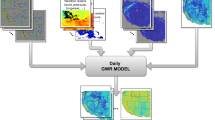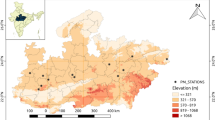Abstract
There has been a growing interest in the use of satellite-retrieved aerosol optical depth (AOD) to estimate ambient concentrations of PM2.5 (particulate matter <2.5 μm in aerodynamic diameter). With their broad spatial coverage, satellite data can increase the spatial–temporal availability of air quality data beyond ground monitoring measurements and potentially improve exposure assessment for population-based health studies. This paper describes a statistical downscaling approach that brings together (1) recent advances in PM2.5 land use regression models utilizing AOD and (2) statistical data fusion techniques for combining air quality data sets that have different spatial resolutions. Statistical downscaling assumes the associations between AOD and PM2.5 concentrations to be spatially and temporally dependent and offers two key advantages. First, it enables us to use gridded AOD data to predict PM2.5 concentrations at spatial point locations. Second, the unified hierarchical framework provides straightforward uncertainty quantification in the predicted PM2.5 concentrations. The proposed methodology is applied to a data set of daily AOD values in southeastern United States during the period 2003–2005. Via cross-validation experiments, our model had an out-of-sample prediction R2 of 0.78 and a root mean-squared error (RMSE) of 3.61 μg/m3 between observed and predicted daily PM2.5 concentrations. This corresponds to a 10% decrease in RMSE compared with the same land use regression model without AOD as a predictor. Prediction performances of spatial–temporal interpolations to locations and on days without monitoring PM2.5 measurements were also examined.
This is a preview of subscription content, access via your institution
Access options
Subscribe to this journal
Receive 6 print issues and online access
$259.00 per year
only $43.17 per issue
Buy this article
- Purchase on Springer Link
- Instant access to full article PDF
Prices may be subject to local taxes which are calculated during checkout




Similar content being viewed by others
References
Liu Y, Park R, Li Q, Kilaru V, Sarnat J . Mapping annual mean ground-level PM2.5 concentrations using Multiangle Imaging Spectroradiometer aerosol opitcal thickness over the contiguous United States. J Geophys Res 2004; 109: 3269–3278.
Liu Y, Sarnat J, Kilaru V, Jacob D, Koutrakis P . Estimating ground-level PM2.5 in the eastern United States using satellite remote sensing. Environ Sci Technol 2005; 39: 3269–3278.
Paciorek CJ, Liu Y, Moreno-Marcias H, Kondragunta S . Spatiotemporal associations between GOES aerosol optical depth retrievals and ground-level PM2.5 . Environ Sci Technol 2008; 42: 5800–5806.
Paciorek CJ, Liu Y . Limitations of remotely sensed aerosol as a spatial proxy for fine particulate matter. Environ Health Persp 2009; 117: 904–909.
Liu Y, Paciorek CJ, Koutrakis P . Estimating regional spatial and temporal variability of PM2.5 concentrations using satellite data, meteorology, and land use information. Environ Health Persp 2009; 117: 886–892.
Kloog I, Koutrakis P, Coull BA, Lee HJ, Schwartz J . Assessing temporally and spatially resolved PM2.5 exposures for epidemiological studies using satellite aerosol optical depth measurements. Atmos Environ 2011; 45: 6267–6275.
Lee HJ, Liu Y, Coull BA, Schwartz J, Koutrakis P . A novel calibration approach of MODIS AOD data to predict PM2.5 concentrations. Atmos Chem Phys 2011; 11: 7911–8002.
Franklin M, Zeka A, Schwartz J . Association between and all-cause and specific-cause mortality in 27 US communities. J Expo Sci Environ Epidemiol 2007; 17: 279–287.
Samet JM, Dominici F, Curriero F, Coursac I, Zeger SL . Particulate air Pollution and mortality in 20 U.S. cities: 1987–1994. New Engl J Med 2000; 343: 1742–1757.
Dominici F, Peng D, Bell M, Pham M, McDermott A, Zeger SL et al. Fine particulates air pollution and hospital admission for cardiovascular and respiratory diseases. JAMA 2006; 295: 1127–1135.
Sarnat SE, Klein M, Sarnat JA, Mulholland J, Russell AG, Flanders WD et al. An examination of exposure measurement error from air pollutant spatial variability in time-series studies. J Expo Sci Environ Epidemiol 2010; 20: 135–146.
Darrow LA, Klein M, Strickland MJ, Mulholland JA, Tolbert PE . Ambient air pollution and birth weight in full-term infants in Atlanta, 1994–2004. Environ Health Persp 2011; 119: 731–737.
Chang HH, Reich BJ, Miranda ML . Time-to-event analysis of fine particle air pollution and preterm birth: results from North Carolina, 2001–2005. Am J Epidemiol 2012; 175: 91–98.
Kloog I, Coull BA, Zanobetti A, Koutrakis P, Schwartz JD . Acute and chronic effects of particles on hospital admissions in New-England. PLoS One 2012; 7: e34664.
Koelemeijer R, Homan C, Mattijsen J . Comparison of spatial and temporal variations of aerosol optical thickness and particulate matter over Europe. Atmos Environ 2006; 40: 5304–5315.
Gupta P, Christopher S, Wang J, Gehrig R, Lee Y, Kumar N . Satellite remote sensing of particulate matter and air quality assessment over global cities. Atmos Environ 2006; 40: 5880–5892.
Brauer M, Amann M, Burnett RT, Cohen A, Dentener F, Ezzati M et al. Exposure assessment for estimation of the global burden of disease attributable to outdoor air pollution. Environ Sci Technol 2012; 46: 652–660.
Berrocal VJ, Gelfand AE, Holland DM . A spatio-temporal downscaler for output from numerical models. J Agric Biol Environ Stat 2010; 15: 176–197.
Berrocal VJ, Gelfand AE, Holland DM . A bivariate space-time downscaler under space and time misalignment. Ann Appl Stat 2010; 4: 1942–1975.
Berrocal VJ, Craigmile PF, Guttorp P . Regional climate model assessment using statistical upscaling and downscaling techniques. Environmetrics 2012; 23: 482–492.
Fuentes M, Raftery AE . Model evaluation and spatial interpolation by Bayesian combination of observations with outputs from numerical models. Biometrics 2005; 61: 36–45.
Paciorek CJ . Combining spatial information sources while accounting for systematic errors in proxies. J Roy Stat Soc C 2012; 61: 429–451.
Gryparis A, Paciorek CJ, Zeka A, Schwartz J, Coull BA . Measurement error caused by spatial misalignment in environmental epidemiology. Biostatistics 2009; 10: 258–274.
Lee D, Shaddick G . Spatial modeling of air pollution in studies of its short-term health effects. Biometrics 2010; 66: 1238–1246.
Szpiro AA, Sheppard L, Lumley T . Efficient measurement error correction with spatially misaligned data. Biostatistics 2011; 12: 610–623.
Szpiro AA, Paciorek CJ, Sheppard L . Does more accurate exposure prediction necessarily improve health effect estimates? Epidemiology 2011; 22: 680–685.
Levy RC, Remer LA, Dubovik O . Global aerosol optical properties and application to Moderate Resolution Imaging Spectroradiometer aerosol retrieval over land. J Geophys Res Atmos 2007; 112: D13210 doi:10.1029/2006JD007815.
Levy RC, Remer LA, Kleidman RG, Mattoo S, Ichoku C, Kahn R et al. Global evaluation of the Collection 5 MODIS dark-target aerosol products over land. Atmos Chem Phys 2010; 10: 10399–10420.
Kaufman CG, Schervish MJ, Nychka DW . Covariance tapering for likelihood-based estimation in large spatial datasets. J Am Stat Assoc 2008; 103: 1545–1555.
Wendland H . Piecewise polynomial, positive definite and compactly supported radial functions of minimal degrees. Adv Comput Math 1995; 4: 389–396.
Chib S, Greenberg E . Understanding the Metropolis-Hastings algorithm. Am Stat 1995; 49: 327–335.
Casella G, George EI . Explaining the Gibbs sampler. Am Stat 1992; 46: 167–174.
R Development Core Team. R: A Language and Environment for Statistical Computing. R Foundation for Statistical Computing: Vienna, Austria. 2012.
Peng RD, Bell ML . Spatial misalignment in time series studies of air pollution and health data. Biostatistics 2010; 11: 393–304.
Chang HH, Peng RD, Dominici F . Estimating the acute health effects of coarse particulate matter accounting for exposure measurement error. Biostatistics 2011; 12: 637–652.
Kumar N, Chu AD, Foster AD, Peters T, Willis R . Satellite remote sensing for developing time and space resolved estimates of ambient particulate in Cleveland, OH. Aerosol Sci Technol 2011; 45: 1090–1108.
Acknowledgements
This study was partially supported by the USEPA grant R834799, NIH grant R01ES019897, and NASA grant NNX09AT52G. Its contents are solely the responsibility of the grantee and do not necessarily represent the official views of the USEPA. Further, USEPA does not endorse the purchase of any commercial products or services mentioned in the publication.
Author information
Authors and Affiliations
Corresponding author
Ethics declarations
Competing interests
The authors declare no conflict of interest.
Additional information
Supplementary Information accompanies the paper on the Journal of Exposure Science and Environmental Epidemiology website
Supplementary information
Rights and permissions
About this article
Cite this article
Chang, H., Hu, X. & Liu, Y. Calibrating MODIS aerosol optical depth for predicting daily PM2.5 concentrations via statistical downscaling. J Expo Sci Environ Epidemiol 24, 398–404 (2014). https://doi.org/10.1038/jes.2013.90
Received:
Accepted:
Published:
Issue Date:
DOI: https://doi.org/10.1038/jes.2013.90
Keywords
This article is cited by
-
Monitoring vs. modeled exposure data in time-series studies of ambient air pollution and acute health outcomes
Journal of Exposure Science & Environmental Epidemiology (2023)
-
Have any effect of COVID-19 lockdown on environmental sustainability? A study from most polluted metropolitan area of India
Stochastic Environmental Research and Risk Assessment (2022)
-
Markov regression model for analyzing big data to predict trajectories of repeated categorical outcomes: an application to \(\hbox {PM}_{2.5}\) air pollution data
Environmental and Ecological Statistics (2022)
-
Performance of MODIS aerosol products at various timescales and in different pollution conditions over eastern Asia
Science China Technological Sciences (2021)
-
Statistical Downscaling with Spatial Misalignment: Application to Wildland Fire \(\hbox {PM}_{2.5}\) Concentration Forecasting
Journal of Agricultural, Biological and Environmental Statistics (2021)



